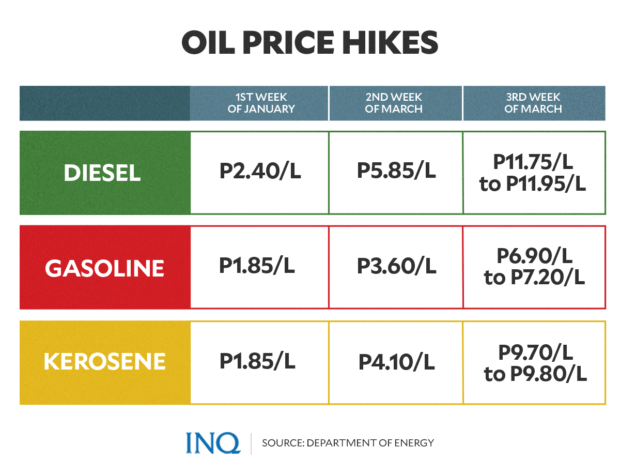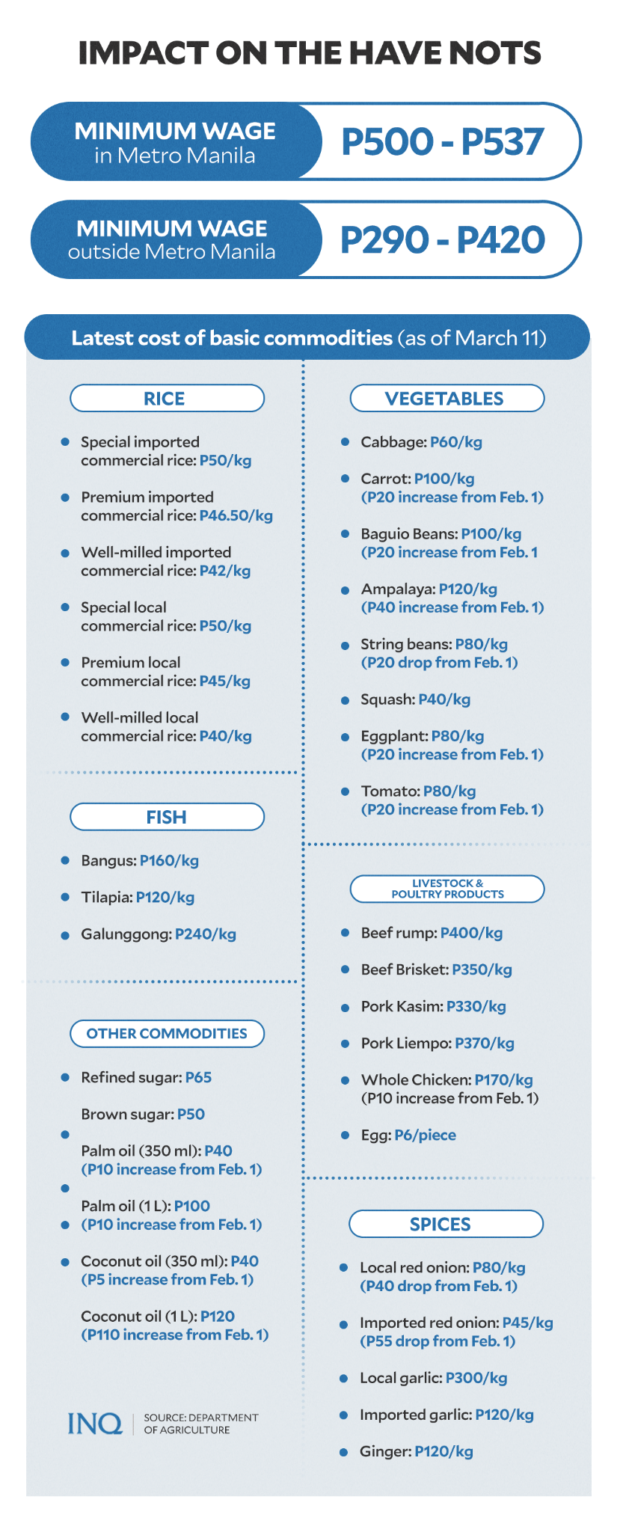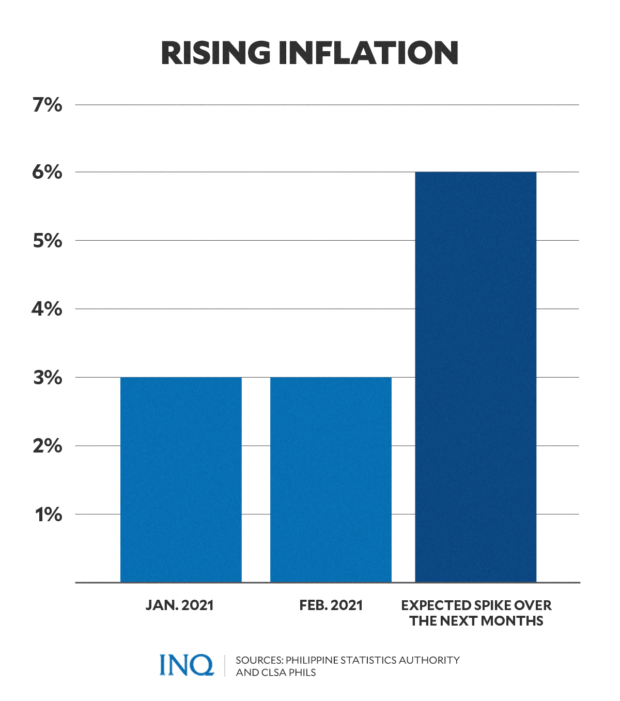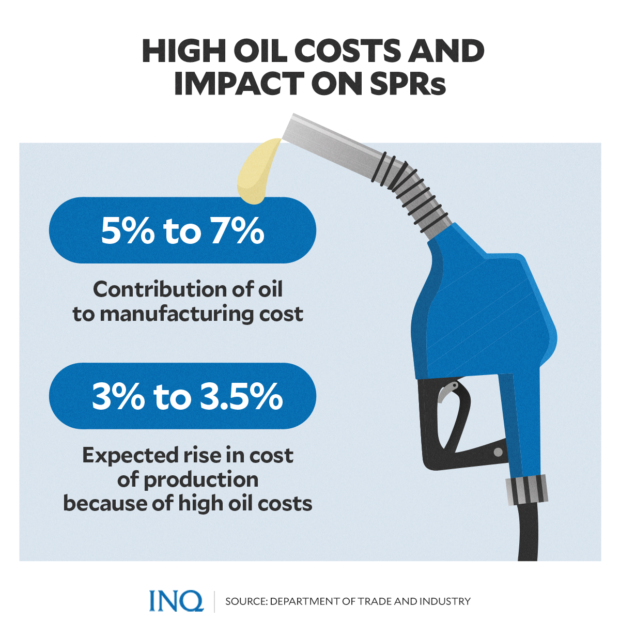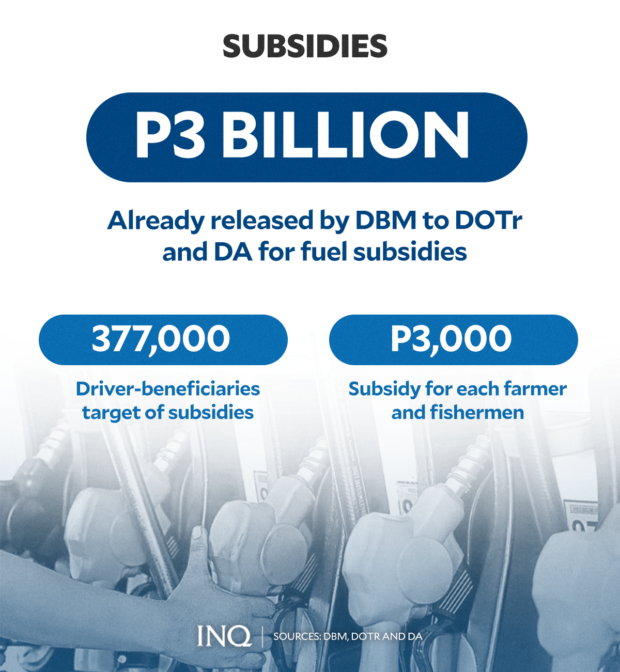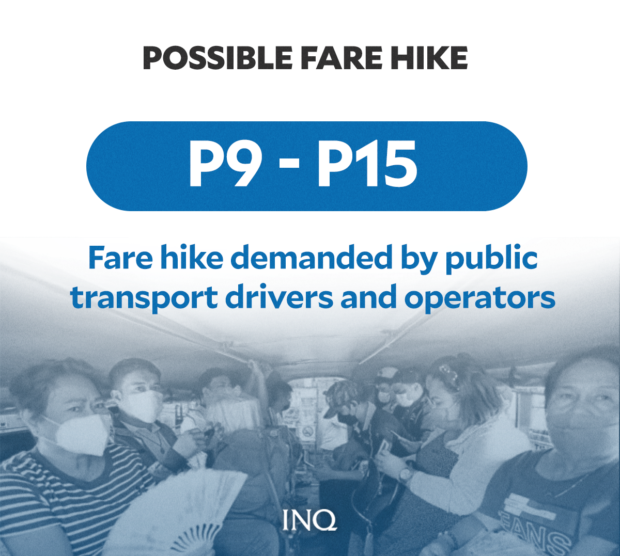Oil price tsunami: Drowning the poor in tougher times
MANILA, Philippines––The relentless rise in oil prices has an “adverse” ripple effect, especially on basic commodities and services––the reason that the poor have always been the worst-hit.
Anakpawis partylist, which represents peasants, workers, fishermen and the poor, said the “endless hikes” sank poor Filipinos who are still rising from the economic standstill brought by COVID-19 lockdowns.
While the government said the effect of the rise in oil costs on the prices of basic commodities and services will be felt only after three months, looking back, a spike has always hit the poor worst.
RELATED STORY: Cusi: Gasoline prices may reach P100 per liter depending on world market
Last year, representatives from the progressive Makabayan bloc filed House Resolution No. 2310 to ask the government to address the grave effects of rising oil prices on basic commodities and services.
Article continues after this advertisementThis was when the costs of diesel, gasoline and kerosene rose by P1.5 per liter, P1.8 per liter and P1.3 per liter. This week, as a barrel of oil is now $139, the hike could be as high as these:
Article continues after this advertisement• Diesel: P11.75 to P11.95 per liter
• Gasoline: P6.90 to P7.20 per liter
• Kerosene: P9.70 to P9.80 per liter
READ: Double-digit fuel price hike expected this week
In this article, INQUIRER.net will explain how rising oil prices will hit immensely––a swell in inflation, a change in suggested retail prices (SRPs), higher fare.
Rising inflation
The Philippine Statistics Authority (PSA) said the inflation last month was three percent. This was because of a decline in “food inflation”––from 1.6 percent to 1.1 percent.
Benjamin Diokno, governor of the Bangko Sentral ng Pilipinas (BSP), told ANC on March 1 that the rise in oil prices will likely drive inflation beyond BSP’s target in the second quarter. CLSA Philippines said inflation could be as high as 5.5 percent to 6 percent in the coming months.
Diokno said rising oil prices, especially because of the Russia and Ukraine conflict, will spill over to local costs and could prompt inflation to exceed BSP’s expected two percent to four percent this year.
RELATED STORY: Putin’s war on Ukraine and impact on PH prices
Last March 8, Albay Rep. Joey Salceda told One News that if oil prices continue to rise, the cost of living in the Philippines may soon become more expensive.
The daily minimum wage in Metro Manila, as set by the National Wages and Productivity Commission, is P537, while the daily minimum wage outside the metropolis is P290 to P420 on the average.
While this is already not enough, especially when compared to the P1,072 “family living wage” in Metro Manila, Salceda said the actual value of the daily minimum wage could be as little as P234 to P464 when adjusted for inflation.
He earlier said that President Rodrigo Duterte should call a special session of Congress by Tuesday (March 15) if the cost of oil is still higher than $100 a barrel, saying that rising oil costs will certainly hit Filipinos.
Higher SRPs?
For Trade Secretary Ramon Lopez, while there should be no changes in the prices of basic commodities for now, the possibility of adjusting SRPs should not be discounted.
He told Dobol B TV on Feb. 23 that high oil costs will hit industries that heavily depend on oil in their operations, saying that this will likewise affect farmers and the fisherfolk.
The PSA said last year that oil resource had the largest share of 0.19 percent in the “non-renewable energy resource rent as percent of gross domestic product” from 2000 to 2019.
Lopez explained that the contribution of oil to “manufacturing cost” is five to seven percent. With high oil costs, there is an expected 3 to 3.5 percent rise in the cost of production.
As the increase in oil prices, which is now in its 11th consecutive week, made the cost of production higher, Lopez said that it might be passed on to Filipino consumers.
He stressed, however, that the Department of Trade and Industry will consider both the rise in oil costs and production costs, like raw materials and logistics, in deciding whether there will be a change in SRPs.
To have a glimpse of the cost of basic commodities now that the effect of rising oil costs is not yet fully felt, here’s a Department of Agriculture list of the prevailing retail costs in Metro Manila:
• Rice
1. Special imported commercial rice: P50/kilogram
2. Premium imported commercial rice: P46.50/kilogram
3. Well-milled imported commercial rice: P42/kilogram
4. Special local commercial rice: P50/kilogram
5. Premium local commercial rice: P45/kilogram
6. Well-milled local commercial rice: P40/kilogram
• Fish
1. Bangus: P160/kilogram
2. Tilapia: P120/kilogram
3. Galunggong: P240/kilogram
• Livestock and Poultry Products
1. Beef rump: P400/kilogram
2. Beef Brisket: P350/kilogram
3. Pork Kasim: P330/kilogram
4. Pork Liempo: P370/kilogram
5. Whole Chicken: P170/kilogram
6. Egg: P6/piece
• Vegetables
1. Cabbage: P60/kilogram
2. Carrot: P100/kilogram
3. Baguio Beans: P100/kilogram
4. Ampalaya: P120/kilogram
5. String beans: P80/kilogram
6. Squash: P40/kilogram
7. Eggplant: P80/kilogram
8. Tomato: P80/kilogram
• Spices
1. Local red onion: P80/kilogram
2. Imported red onion: P45/kilogram
3. Local garlic: P300/kilogram
4. Imported garlic: P120/kilogram
5. Ginger: P120/kilogram
• Other commodities
1. Refined sugar: P65
2. Brown sugar: P50
3. Palm oil: P40/P350 mL
4. Palm oil: P100/1 L
5. Coconut oil: P40/P350 mL
6. Coconut oil: P120/1 L
This, as Anakpawis said there was an 11 percent to 14 percent rise in food cost from 2019 to January 2022. The spike was highest in Central Visayas with 14 percent, and in Calabarzon and Bicol Region with 13 percent.
Fare hike
As jeepney drivers were likewise hit by the hike in oil prices, they asked the Land Transportation Franchising and Regulatory Board (LTFRB) to increase the minimum fare from P9 to P15. The LTFRB has yet to hear the petition.
RELATED STORY: Government cool to fare hike as fuel prices shoot up
“The continuously increasing inflation rate, which kicks up the prices of the basic commodities, pushed the PUJ stakeholders to the edge and can no longer provide 3x a day meal to their respective families.”
The Liga ng mga Transportasyon at Operators sa Pilipinas said this compelled it to ask for a “conservative fare increase” of P15 as the minimum fare for the first 4 kilometers.
READ: LTFRB: Minimum fare stays at P9 for now; bid to increase it to P10 up for decision
For now, however, the LTFRB said the minimum fare would stay the same. It likewise warned that drivers charging passengers more than P9 will risk paying thousands of pesos in fines.
READ: LTFRB warns jeepney drivers who can’t wait for fare hike
With rising oil prices, 1-UTAK chairperson lawyer Vigor Mendoza told dzBB that some jeepney drivers now plan to stop plying routes by Tuesday or Wednesday.
“There will really be drivers who still stop operating. It’s not that they’re protesting or anything but they really don’t make money anymore,” he said in Filipino.
Gov’t subsidy
The Department of Budget and Management already released P3 billion for fuel subsidy programs––P2.5 billion to the Department of Transportation and P500,000 to the Department of Agriculture (DA).
The LTFRB said over 377,000 drivers of public utility vehicles–– jeepneys, mini buses, UV express, taxis, tricycles, TNVS, motorcycle taxis, and even delivery services––are set to receive P6,500 each in subsidy.
The DA likewise said farmers and fisherfolk will receive P3,000 each: “[The amount of] P500 million is now ready to be given this March.” The guidelines, the DA said, are now in the “final stages of preparation.”
READ: Fuel subsidy set for agrisector; P3 price hike seen
However, Anakpawis stressed that since last year, there was an additional P16,620 in the two-month expenses of drivers for diesel; P7,500 in the expenses of farmers for land preparation and irrigation; and P9,000 in the expenses of fisherfolk.
As it initiates a week-long protest, Anakpawis said it will fight for the suspension of VAT and excise on oil.
READ: Lift excise tax on oil products amid big time price hike — Hontiveros
RELATED STORY: Additional P600-M fuel subsidy for farmers, fishers
TSB

